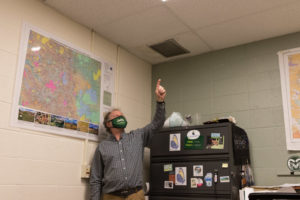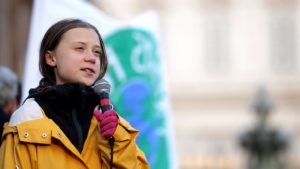It is not every day that an assignment in a college course has a tangible outcome in the real world, but that was the case for Colorado State University students participating in the Spring 2020 Practicing Sustainability course when their recommendations for lessening carbon emissions were instated by the Colorado Natural Heritage Program.

A group of eight students in the capstone course ESS440 worked closely with the center on campus to measure and track their carbon output then recommend changes in a final presentation. One recommended change was swapping out the overhead fluorescent light bulbs in their office space to energy-saving LED lightbulbs, and CSU facilities recently made that change in the Fall of 2020.
Each semester, groups of students in the course, offered through the Ecosystem Science and Sustainability department in the Warner College of Natural Resources, are paired with a local stakeholder of their choosing to address a sustainability issue within the stakeholder’s organization. The course creates opportunity for students to use their education to consult an organization on real issues, said Professor Julia Klein, a co-instructor in the course.
“We’re looking to [the students] to be the change makers of the present and the future,” Klein said. “What’s exciting about this is that they have a lot of knowledge, and this class puts them in the place of actually being able to have…a tangible impact on sustainability both at CSU and within the greater Fort Collins community.”
Inspired by Greta Thunberg’s carbon challenge

The Colorado Natural Heritage Program sought involvement as a stakeholder in the capstone course after receiving $10,000 from a donor family for a “Carbon Challenge,” to decrease their carbon emissions, a challenge inspired by Swedish climate activist Greta Thunberg who called on individuals and organizations not to wait on governments to change their carbon use. Staff at CNHP divided into five groups to compete for who could reduce carbon emissions the most—in both their home and work life.
“The donor family wanted us to ‘gamify’ this challenge,” said Dave Anderson, director of CNHP. The students made recommendations with the plan is for students in the 2021 course to measure again and declare a winner. “The beauty of this is that all of us are winners by reducing our carbon footprint together, and that we can help others at CSU to do this as well, while getting to work with the wonderful ESS students to make it happen.”
The students in the Spring 2020 course worked closely with CNHP team members to determine their goals and measure a baseline of their various home and work carbon outputs over the semester. They took measurements in each room of the CNHP offices and calculated the utilities used. They then worked with CSU facilities to determine what actions could be taken to include in their recommendations.
The teamwork between the students, stakeholders and the University make for a realistic view of sustainability work in the real world, said Research Scientist Stacy Lynn, co-instructor of the course.
“The students functioning well as a team will create a collective product or more than one product. The other part is listening to a stakeholder—understanding what the stakeholder’s needs are to create a plan,” Lynn said. “Collaboration with each other and with their stakeholder is a fantastic opportunity for them to grow their skills as collaborative workers.”
Recommending big changes
When measuring the fluorescent lights in place, the students determined that kilowatt hours could be saved by changing to LED lights, reducing the center’s carbon output. Throughout the process, the group enthusiastically worked to discuss real options and give attainable solutions, said Abby Blumenthal, an ESS440 student on the carbon challenge team.
“My favorite part was brainstorming ideas with my group. We are really passionate about wanting to reduce the carbon footprint and making that happen, rather than it being, ‘Oh, it would be nice if you could do this,’” Blumenthal said. “We were finding solutions they could actually do.”
While the group’s final presentation included the recommended switch to LED lights as well as changes for commuting to and from work and improvements to food and waste behaviors, the team also posed a challenge for others at CSU to take on the carbon challenge.
“We were thinking a lot of the people who attend and work at CSU are environmentally-minded, so this might be something that is good for them, as well,” Blumenthal said. “It’d be interesting to see if every department or office space took part in this challenge and how that could lower CSU’s carbon footprint.”
The LED lights were installed after many of the students in the capstone course like Blumenthal had already graduated, so she was informed of the installation via email. While she said she felt fulfilled by the work she completed in the class, the news of their recommended changes being made was a bonus.
“I can put my class experiences on my resume and say, ‘I learned how to do this. I took measurements and came up with solutions,’” Blumenthal said. “I emailed to see how the carbon challenge is going. It’s cool that it’s not something that just fizzled out, and it is so nice to hear it’s something we started that’s hopefully going to continue for them year after year.”
To view the group’s full list of deliverables, watch their presentations here.